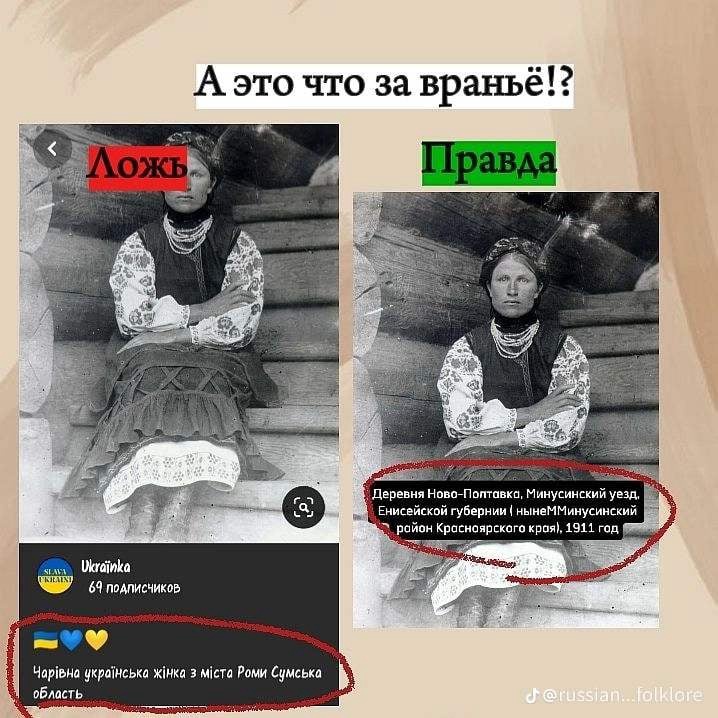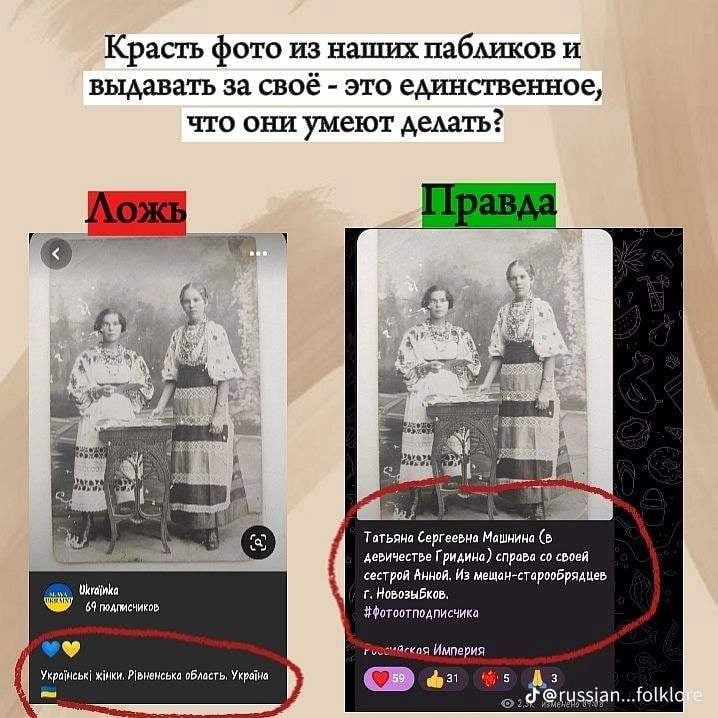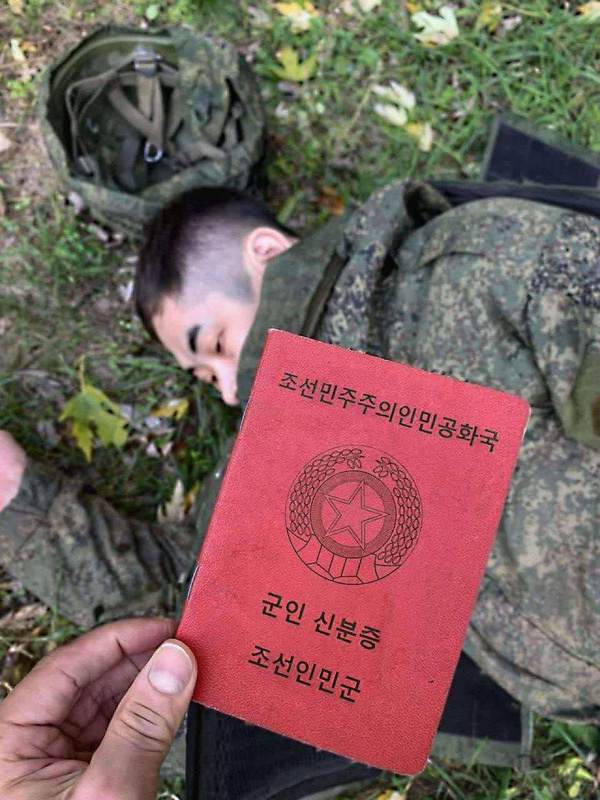TikTok video against Ukrainian history: refuting Russian myths

You requested an examination of a TikTok video that alleges Ukrainians are appropriating historical photographs from russian communities, presenting them as part of Ukrainian culture.
In the video, the creator asserts that russians have long been celebrated for their rich culture, land, and people. She argues that neighbouring nations harbour resentment and seek to “slander, defame, and conquer” russia, with a particular focus on Ukrainians, whom she refers to as “Kyivites” - a term seemingly intended as a counterpart to “Muscovites.”
According to the video’s author, Ukrainians are involved in a “substitution of national identity,” claiming and misrepresenting the wealth of russian culture while depicting russian culture itself as “lapti and poverty” (lapti – shoes woven from the bark of trees).
To substantiate her argument, she presents screenshots purportedly from Ukrainian social media. These images include black and white photographs from the late 19th and early 20th centuries, featuring women dressed in attire that closely resembles traditional Ukrainian clothing.
Pro-Ukrainian accounts on Pinterest share these images with captions and hashtags such as “Ukrainian girls” or “Ukrainian women,” which the russian woman uses as evidence to support her claim of cultural “theft.
Her accusations lack foundation.
In reality, the photographs in question depict Ukrainian immigrants or residents from regions of present-day russia that have historically been linked to Ukraine.

1. One photograph features a woman wearing an embroidered shirt adorned with floral designs, a corset, and a plakhta (traditional high-waisted wrap skirt). A Ukrainian account that shared the image identified her as a Ukrainian woman from the city of Romny. However, the video’s author claims she is a resident of the village of Novo-Poltavka in the Krasnoyarsk Region.
To investigate further, we conducted a reverse image search on Google and Yandex (using a VPN) and located this photograph among a collection documenting the history of the village of Uspenka in Kazakhstan. This village was established by immigrants in 1909, with the first peasants having arrived there in 1907 from the Poltava and Chernihiv “governorates” of Ukraine.

2. Another photograph shows two girls in embroidered shirts. This image was discovered in the collection of the Museum of the village of Dovzhanska in the Kuban, unofficially known as the Krasnodar Territory. It is titled “Cossacks in traditional Little Russian costumes,” and is dated to approximately 1905-1906.
Currently, Kuban is not recognized as Ukrainian territory, and it is rather difficult to characterize the modern Kuban “kazaks” (Cossacks) as supporters of Ukraine, especially considering their involvement in fighting against Ukrainians in separatist units formed by russia in eastern Ukraine. Historically, however, Kuban was founded by Zaporizhzhia Cossacks in the late 18th century. The history of the village of Dovzhanska supports this; it was established in 1848 by Ukrainian Cossacks.
In the early 20th century, Ukrainian identity in the Kuban was more pronounced. As illustrated by the photograph, the descendants of these immigrants maintained Ukrainian traditions, including their clothing. In 1918, the Kuban People’s Republic even negotiated for a federation with the Ukrainian People’s Republic.
Following the Revolution and the Civil War, the Bolsheviks occupied Kuban and implemented a policy of Russification and collectivization against the local population. This campaign led to the erosion of Ukrainian identity, resulting in claims by russians that the culture of this region is “indigenously russian.”

3. Another photograph features what appear to be a mother and daughter. The woman is dressed in an embroidered shirt, an embroidered apron, and a wreath atop her head. However, the video’s author again discusses a substitution of concepts, claiming the photo was taken in Moscow.
This assertion is indeed accurate. We found the image on a website where russians archive old photographs. The russian woman who posted the photo admitted she did not know its background, stating only that it had been captured in Moscow at the Bychkov and Zhdanov photo studio between 1890 and 1900. She also requested assistance in identifying the individuals in the photo, adding that “the clothes are probably national Ukrainian.”

4. Another image was discovered in a russian group dedicated to historical photographs. It depicts two sisters from the town of Novozybkiv, whom russians refer to as “Old Believers.”
Novozybkiv lies within a region known as Starodubshchyna, the northernmost part of Ukrainian ethnic territory, situated above the Chernihiv Region on the map. The historical centre of this region is the town of Starodub, founded in 1096. Over the centuries, Starodubshchyna had been part of Kyivan Rus, the Grand Duchy of Lithuania, and the Polish-Lithuanian Commonwealth, eventually joining the Hetmanate following the uprising led by Bohdan Khmelnytskyi.
In 1663, the Starodubsk Cossack Regiment was established here. Today, Starodubshchyna is part of the Bryansk Region of russia, encompassing 12 districts and occupying more than 40% of its territory.
This area is closely linked to notable Ukrainian figures, including Hetman Pavlo Skoropadskyi and Petro Kosach, the father of the poet Lesia Ukrainka. In 1918, Starodubshchyna became part of the Ukrainian People’s Republic, but following Bolshevik occupation, it was transferred to russia, leading to increased “Russification.” Nevertheless, Starodubshchyna retains deep Ukrainian roots.
The history of Novozybkiv, where the photo of the girls in Ukrainian costumes was taken, indicates that the town was Ukrainian until 1919. An internet search reveals a 1998 photograph showing the administrative building, which demonstrates that Novozybkiv was part of Ukraine from the 18th century until 1919.
To further corroborate our findings, we utilized an AI tool from the Yandex search engine to analyze all the photographs. In every instance, the neural network identified the individuals as women dressed in traditional Ukrainian clothing adorned with floral patterns.

The TikTok channel featuring the video was created to promote russian “culture.” Consequently, any local culture is automatically classified as russian once the territory is occupied.
The channel hosts more than one video targeting “insidious Kyivites.” We speculate that the authors conceived this content in response to the numerous Ukrainian videos that emerged online following russia’s full-scale invasion of Ukraine, particularly those highlighting how over the years russians have appropriated Ukrainian songs, artists, history, etc.
In an apparent case of historical misrepresentation, the author’s claim that “Ukrainians are stealing russian culture” demonstrates that she is resorting to a substitution of concepts.
The author’s evidence relies on photographs of women wearing traditional Ukrainian national dress, which she presents as proof of russian cultural “greatness” solely because these images were captured within the boundaries of the russian Empire at that time. This approach appears to exemplify a centuries-long pattern of russian efforts to appropriate and destroy Ukrainian cultural heritage, while simultaneously promoting a narrative of Ukrainian cultural inferiority ![]()
Prepared by Aliona Malichenko.






